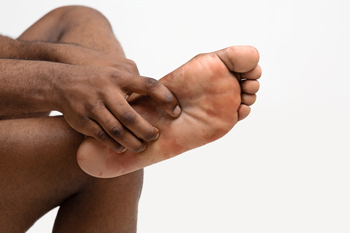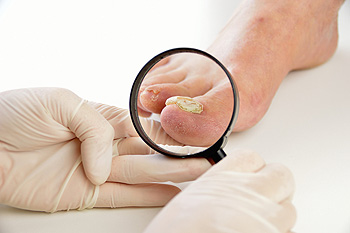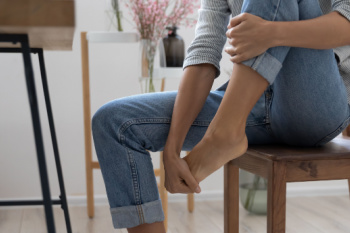
Pain on the bottom of the foot while walking can result from several conditions affecting the nerves, bones, and soft tissues. Metatarsalgia occurs when the ball of the foot experiences excessive pressure, leading to inflammation and discomfort. Peripheral neuropathy, often linked to diabetes, causes nerve damage that leads to tingling, burning, or sharp pain. Morton's neuroma is a thickening of nerve tissue between the toes, creating a sensation similar to stepping on a pebble. Additionally, sesamoiditis, an inflammation of the small sesamoid bones beneath the big toe, can cause pain with every step. If you have foot pain, it is suggested that you consult a podiatrist who can determine what the cause is, and offer effective relief and treatment solutions.
Foot Pain
Foot pain can be extremely painful and debilitating. If you have a foot pain, consult with Dr. Douglas Mckay from New Jersey . Our doctor will assess your condition and provide you with quality foot and ankle treatment.
Causes
Foot pain is a very broad condition that could be caused by one or more ailments. The most common include:
- Bunions
- Hammertoes
- Plantar Fasciitis
- Bone Spurs
- Corns
- Tarsal Tunnel Syndrome
- Ingrown Toenails
- Arthritis (such as Gout, Rheumatoid, and Osteoarthritis)
- Flat Feet
- Injury (from stress fractures, broken toe, foot, ankle, Achilles tendon ruptures, and sprains)
- And more
Diagnosis
To figure out the cause of foot pain, podiatrists utilize several different methods. This can range from simple visual inspections and sensation tests to X-rays and MRI scans. Prior medical history, family medical history, and any recent physical traumatic events will all be taken into consideration for a proper diagnosis.
Treatment
Treatment depends upon the cause of the foot pain. Whether it is resting, staying off the foot, or having surgery; podiatrists have a number of treatment options available for foot pain.
If you have any questions, please feel free to contact one of our offices located in Caldwell, and Galloway, NJ . We offer the newest diagnostic and treatment technologies for all your foot care needs.

Toenail fungus, medically termed onychomycosis, occurs when fungi grow excessively in or under the toenail, resulting in thickened, brittle, or discolored nails. The risk of developing fungal toenails increases with prolonged exposure to warm, moist environments, such as wearing closed-toe shoes for extended periods or walking barefoot in gym showers and pool areas. People with diabetes, poor circulation, a weakened immune system, or a history of nail injuries are more susceptible to infection. Aging also plays a role, as slower nail growth and reduced blood flow to the feet increase the risk. Improperly sanitized tools at nail salons can spread fungal infections from one person to another. Symptoms may develop gradually, making early detection difficult. If left untreated, the infection can worsen, causing pain or the nail to separate from the nail bed. A podiatrist can assess the severity of the infection and provide treatment, including topical or oral medication, laser therapy, or possible nail removal. If you believe you have a toenail fungus, it is suggested that you schedule an appointment with a podiatrist for an exam, diagnosis, and appropriate treatment options.
For more information about treatment, contact Dr. Douglas Mckay of New Jersey . Our doctor can provide the care you need to keep you pain-free and on your feet.
Toenail Fungus Treatment
Toenail fungus is a condition that affects many people and can be especially hard to get rid of. Fortunately, there are several methods to go about treating and avoiding it.
Antifungals & Deterrence
Oral antifungal medicine has been shown to be effective in many cases. It is important to consult with a podiatrist to determine the proper regiment for you, or potentially explore other options.
Applying foot powder on the feet and shoes helps keep the feet free of moisture and sweat.
Sandals or open toed shoes – Wearing these will allow air movement and help keep feet dry. They also expose your feet to light, which fungus cannot tolerate. Socks with moisture wicking material also help as well.
If you have any questions please feel free to contact one of our offices located in Caldwell, and Galloway, NJ . We offer the newest diagnostic tools and technology to treat your foot and ankle needs.

Toenail problems can indicate underlying health issues, with several distinct conditions affecting the nails. Beau's lines are horizontal indentations that can occur when growth is temporarily disrupted by illness, injury, or stress. Clubbing refers to a rounding of the toenails and fingertips, often associated with lung or heart disease. Green nail syndrome is a bacterial infection caused by Pseudomonas bacteria, leading to a green discoloration of the nail. Koilonychia, also known as spoon nails, causes nails to become thin and concave, potentially linked to iron deficiency anemia. Additionally, median nail dystrophy is a condition where the nails develop vertical grooves or splits, which may be a result of trauma or skin conditions. These toenail problems should not be ignored, as they may be a sign of nutritional deficiencies, infections, or systemic health conditions that require attention. If you have any of these toenail conditions, it is suggested that you consult a podiatrist who can offer effective treatment remedies.
Toe pain can disrupt your daily activities. If you have any concerns, contact Dr. Douglas Mckay of New Jersey . Our doctor can provide the care you need to keep you pain-free and on your feet.
What Causes Toe Pain?
Most severe toe pain is caused due to a sports injury, trauma from dropping something heavy on the toe, or bumping into something rigid. Other problems can develop over time for various reasons.
Toe pain can be caused by one or more ailments. The most common include:
- Trauma
- Sports injury
- Wearing shoes that are too tight
- Arthritis
- Gout
- Corns and calluses
- Hammertoe
- Bunions
- Blisters
- Ingrown toenails
- Sprains
- Fractures (broken bones)
- Dislocations
When to See a Podiatrist
- Severe pain
- Persistent pain that lasts more than a week
- Signs of infection
- Continued swelling
- Pain that prevents walking
Diagnosis
In many cases the cause of toe pain is obvious, but in others, a podiatrist may want to use more advanced methods to determine the problem. These can range from simple visual inspections and sensation tests to X-rays and MRI scans. Prior medical history, family medical history, and any recent physical traumatic events will all be taken into consideration for a proper diagnosis.
Treatment
Treatments for toe pain and injuries vary and may include shoe inserts, padding, taping, medicines, injections, and in some cases, surgery. If you believe that you have broken a toe, please see a podiatrist as soon as possible.
If you have any questions please feel free to contact one of our offices located in Caldwell, and Galloway, NJ . We offer the newest diagnostic tools and technology to treat your foot and ankle needs.


